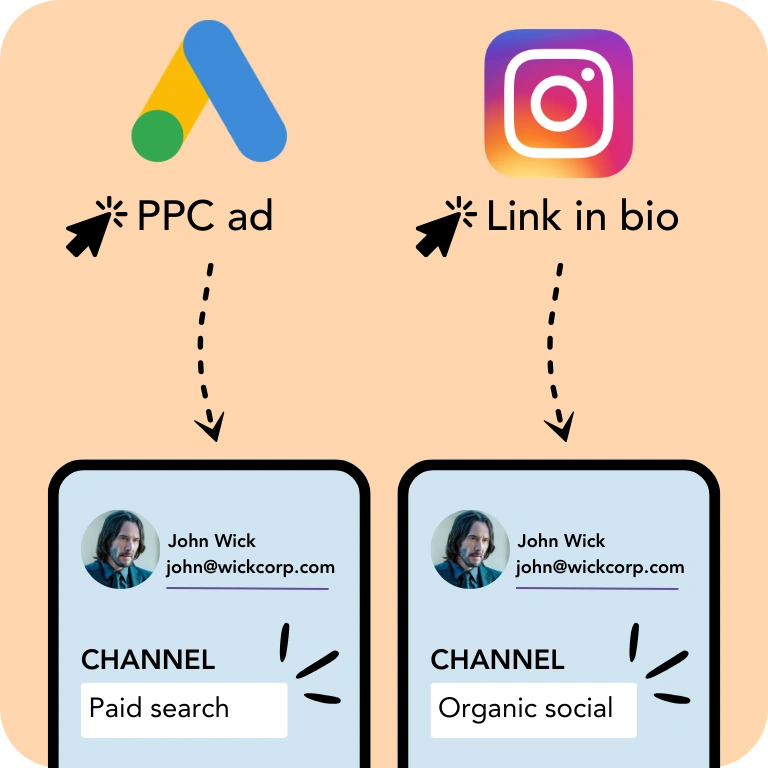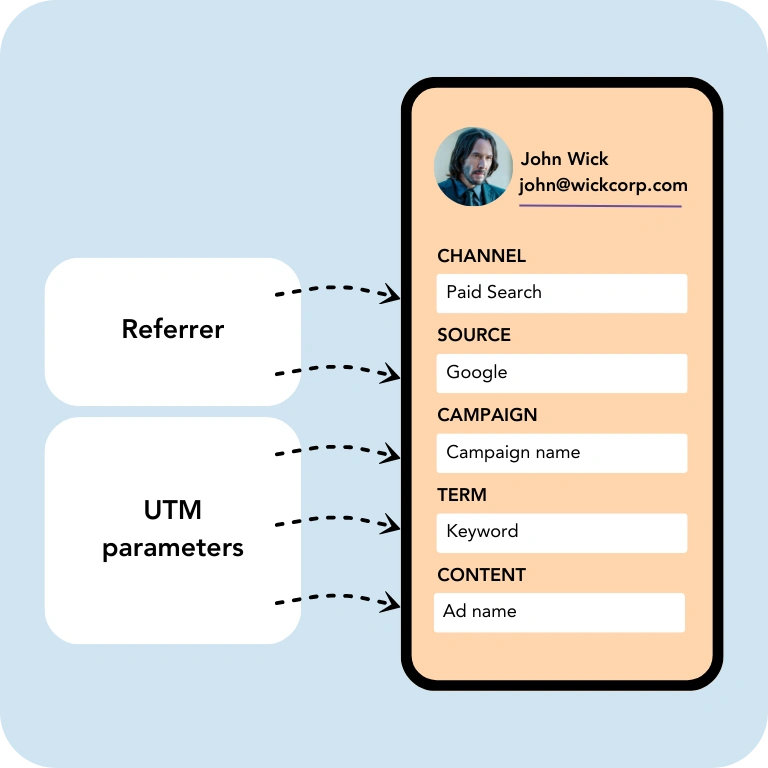Track the source of your leads directly through your online form.
More than 100 companies track the source of their leads with LeadSources

Smart channel attribution
Automatically assign each lead to a unified channel naming, eliminating inconsistencies.

Track UTM & referrer data
Aggregate UTM parameters and referrer data for a complete view of where your leads came from.

Measure ROAS
Link revenue back to lead sources to measure ROAS across channels, campaigns, keywords, and ads.
Average results recorded by our clients after 6 months.
Insert the tracking code in the head tag of your website. LeadSources will fetch the UTM parameters and referrer data from every visitor.
Add a hidden field in your form for each lead source you want to track.
When a visitor submits your form, LeadSources stores the lead source data in the hidden field:
Connect your form to a CRM to track the source of your sales and revenue.
Connect closed deals and revenue to their lead source. Identify the highest-value marketing channels. Make data-driven ROI decisions.
Try it for free for 14 days!
No. LeadSources integrates with your current form builder.
Leadsources integrates with 110+ apps that collect leads:
LeadSources tracks and combines data from various sources (referrer and UTM parameters) to provide robust lead source data.
Yes. When you can’t use UTM parameters (like in organic channels – Google, LinkedIn post, etc.) Leadsources will use the referrer to still captures the source of your leads.
Leadsources will still provide you with:
Leadsources captures up to 7 lead source data for each lead generated:
Refer to this help article for more information:
Leadsources stores the lead source data in the result page of your form builder. So you can see the lead source data alongside the lead details (name, email, etc.).
Leadsources integrates with all the popular form builders, and we have created a step-by-step guide for each integration.
First, you need to send your leads to your CRM to track which leads converted into a sale.
Then, simply download from your CRM the leads that transformed as customer – make sure to also download the revenue generated.
Open the document on Excel or Google Sheets.
Play with the data to measure the sales or revenue by channel, source, campaign, term, content, landing page, and landing page subfolder.
14 days. You can cancel at any time within your first 14 days, and you won’t be charged. After, you’ll be charged on monthly basis according to the plan you selected.
Yes. There is no engagement. You can cancel your subscription at any time.
Here is the process to start tracking the source of your leads:
A lead source is the channel or method through which a potential customer discovers your business and becomes a lead. This could be through organic search, paid advertising, social media, referrals, or other marketing channels.
Common lead sources include:
✔️ Organic Search (SEO)
✔️ Paid Search (SEM/PPC)
✔️Social Media (organic & paid)
✔️ Email Marketing
✔️ Referral Traffic
✔️ Direct Traffic
Lead source tracking allows you to identify which marketing channels are most effective at generating quality leads. This information helps you make data-driven decisions about where to invest your marketing resources.
Benefits of proper lead source tracking:
✔️ Optimize marketing budget allocation based on channel performance
✔️ Identify which channels produce the highest quality leads and customers
✔️ Calculate accurate customer acquisition costs (CAC) by channel
✔️ Make data-driven decisions about which marketing activities to scale
LeadSources is a lead source tracking software created for those like us who simply want to track the source of their leads. Nothing else.
To install this lead source tracking tool on your site, you simply have to insert the LeadSources script in your header. It’s compatible with all CMS.
It integrates with your form builder so you don’t have to change your lead generation funnel.
When someone visits your site, LeadSources tracks the lead source data and passes it into your form as hidden fields, as shown in the example with Typeform
| Lead source data | Definition |
| Channel | Organic Search, Paid Search, Organic Social, Referral, etc.) |
| Source | Facebook, Instagram, etc. |
| Campaign | The name of the specific marketing campaign. For example, when running several campaigns on Google Ads, you can track which exact campaign your leads came from. |
| Term | The keyword targeted by a specific campaign. Example: you run a Google Ads campaign called “Search campaign corporate lawyers”. LeadSources categorizes your leads by keyword targeted: “Corporate lawyer in New York”, “Corporate lawyer in Miami”, etc. |
| Content | The exact element of your ad that was clicked. |
| Landing page | The URL of the landing page where the lead landed. Examples: domain.com/services/corporate-lawyer-miami |
| Landing page subfolder | This isolates the subfolder of the landing page. Example: a visitor lands on the page domain.com/services/corporate-lawyer-miami. The subfolder tracked is “services”. |
Once the visitor submits the form, the lead source data can be found on the submission page of your form builder, alongside the leads details (name, email, phone number, etc.):
Once you track which source your leads are coming from, you can make data-driven decisions. Focus on the channels that brought the most leads. Dig deeper by leveraging the “Sales and revenue per channel” report, and you can allocate the budget to the channels that brought the most sales and revenue.
Second, in marketing, segmentation is king. When you track the source of each lead, when a new lead enters your sales funnel, you can tailor your communication based on the source the lead came from. Providing a personalized experience and potentially increasing the conversion rate as a result.
Third, marketing is a dynamic environment. And seasonality can impact the way customers approach your business.
For example, during low seasons, your LinkedIn outreach channel could be the most performing. While in high seasonality, emailing could be the main acquisition channel.
The bottom line is that we evolve in a dynamic environment.
Tracking the source of your leads over time allows you to quickly adapt to new acquisition patterns by reactively reallocating your marketing budget to the channels providing the most leads.
This allows you to increase your revenue and optimize your marketing costs throughout the year.
Automated page speed optimizations for fast site performance